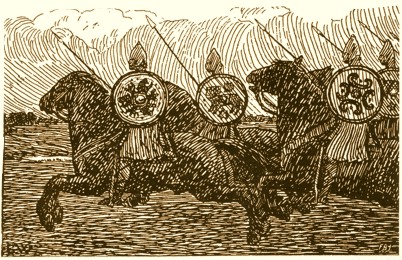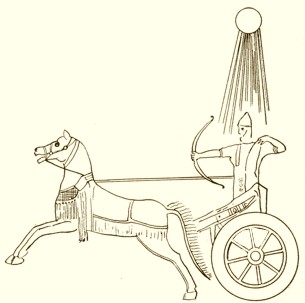![]()
![]()
THE KINGDOM OF MITANNI PART II

The Mitanni armies were composed of highly skilled professional troops. Their elite warriors were the maryannu, the horsemen and the charioteers of the aristocracy. The Mitanni chariots served as the models for the chariots of the neighboring armies. Mitanni chariots were sleek platforms with two wheels and a team of two horses. The horses and the maryannu warrior were well armored -- covered in bronze or iron scale armor. The attendants included archers that would fight with the noble charioteer from the chariot and the servants would attend the horses. The Armenian-Hurrian-Hyksos [Hayksos] extended their domain through Palestine to Egypt.

ARMENIAN NOBLE WARRIOR UNDER THE PROTECTION OF
T H E S U N N Y R A Y S O F A R
-- R A
A treaty in about 1380 B.C. between Mitannian King Artašumara and the kinsmen Hittite king Arnuwanda I calls a list of kinsmen gods to witness. Among them are the Armanen God of Light and the Sun Mithras, the Sky God Vahagn-Varuna, and Ardini-Indra, all of the deities that would be also later worshipped by the Indo-Aryans and recorded in the Rig Veda. An Armenian named Kikkuli from the Kingdom of Mit[r]anni wrote a manual for horse trainers using specifically Armenian terms. Without a doubt the Armenian cavaliers were the acknowledged experts of horse breeding, training and riding. Scythians, Sarmatians, Cimmerians were all Indo-European off-shoots who ventured from the Indo-European Homeland-Armenian Highland beyond the Caucasus and Central Asia, their techniques would later on be taken over by all of the peoples of the steppes and beyond.
![]()
![]()